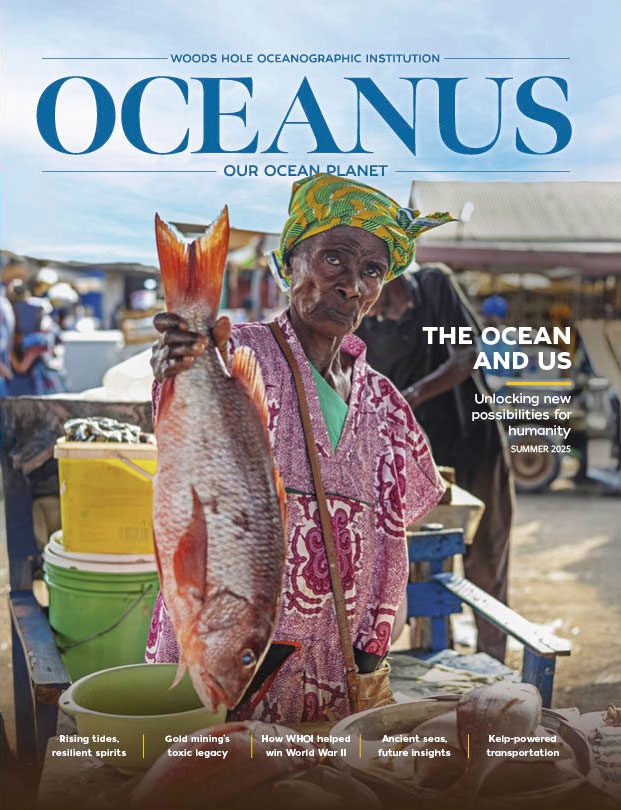Twilight Zone
Scientist Zoleka Filander collaborates with WHOI on a children’s book
Even ‘Twilight Zone’ Coral Reefs Aren’t Safe from Bleaching
All the fish we cannot see
Great white sharks are hanging out in the twilight zone and scientists don’t know why
Shark chased off by seals along Cape Cod, school of bluefish spotted rubbing up against a shark
Fierce hunters sparkle with bioluminescence in the twilight zone, but it’s under threat
Scientists drop robot into dark ocean, film weird brilliant world
WATCH: New England-based researchers share rare video from ocean’s ‘Twilight Zone’
Entering ‘the twilight zone.’ Woods Hole scientists, author team up on new children’s book
The ocean twilight zone could store vast amounts of carbon captured from the atmosphere – but first we need an internet of deep ocean sensors to track the effects
Woods Hole scientists exploring what’s inside the ocean’s ‘twilight zone’
Call of the deep
Warming Trends: Extracting Data From Pictures, Paying Attention to the ‘Twilight Zone,’ and Making Climate Change Movies With Edge
11 epic mysteries scientists totally can’t solve
As you dive deeper into the ocean, less and less sunlight shines through, and about 200 meters beneath the surface, you reach an area called the “twilight zone.”
11 epic mysteries scientists totally can’t solve
Explorers, Scientists, and Advocates James Cameron, Ray Dalio, Peter de Menocal, and Dr. Edith Widder to Discuss Ocean Twilight Zone for Public Unveiling of Historic Art Installation
″ Illuminating the Abyss ” will take place on Tuesday, September 21, at 7:30 PM ET. The event will be hosted by renowned ocean research organization Woods Hole Oceanographic Institution (WHOI) and moderated by climate reporter and author Tatiana Schlossberg.
How an underwater robot could help reveal mysteries of the deep
Enter Mesobot, a state-of-the-art aquatic explorer designed to help unravel some of those unknowns, and improve our existing knowledge.
Sharks and the ocean’s twilight zone: Some female great white sharks can deep dive for hours
Much of the shark focus around the Cape is on great whites roaming close to the shoreline as they prowl for seals, but researchers are finding out that several sharks are actually diving deep into the twilight zone out in the middle of the ocean. Scientists at Woods Hole Oceanographic Institution on Cape Cod are researching the sharks’ deep diving behavior and how sharks’ bodies have evolved to handle these deeper conditions. They’re learning that deep diving is far more frequent and extensive across species than previously thought, said Simon Thorrold, a senior scientist in the biology department at the Woods Hole Oceanographic Institution.
‘What we know now is how much we don’t know’: Enter the strange world of the ocean twilight zone
A difficult area to study and often overlooked by science, new technology is aiding its exploration, forcing researchers to re-evaluate just how much life is down there. Researchers now believe there is 10 times, maybe 100 times the biomass previously thought, says Heidi Sosik, senior scientist at Woods Hole Oceanographic Institution (WHOI).
Tracking Carbon From the Ocean Surface to the Dark “Twilight Zone”
Much of the science focuses on the ocean’s role in the global carbon cycle. Through chemical and biological processes, the ocean removes as much carbon from the atmosphere as all plant life on land.
Tracking carbon from the ocean surface to the twilight zone
Much of the science focuses on the ocean‘s role in the global carbon cycle.
“It’s deep. It’s dark. It’s elusive.” The ocean’s twilight zone is full of wonders.
“It’s been called the greatest migration on Earth,” says Annette Govindarajan, a WHOI oceanographer who also does twilight zone research.
Scientists are tracking down deep sea creatures with free-floating DNA
Traditional methods, which include trawling and baited cameras, can only offer snapshots of the complex deep-ocean world, says Elizabeth Allan, a postdoctoral investigator at WHOI who works on the Institute’s ocean twilight zone project.
The Earth-Shaping Animal Migration No One Ever Sees
“All the vehicles on the road in the United States produce around 1.5 PgC per year,” says Kevin Archibald, a biological oceanographer at WHOI and lead author of that study. DVM could be understood as offsetting about two-thirds of all U.S. automobile emissions.














